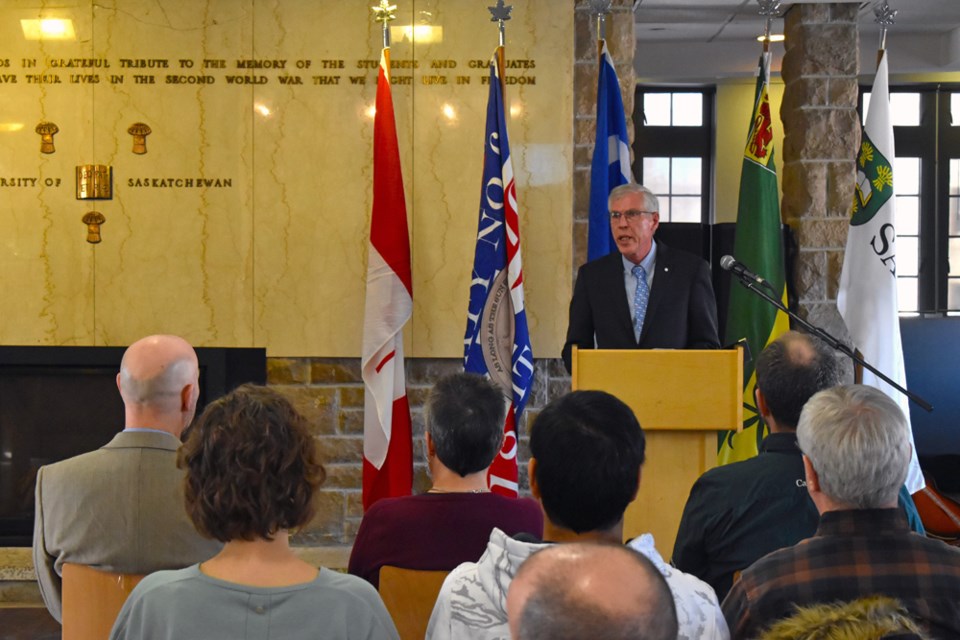SASKATOON — A plaque honouring the contributions made by the late Dr. Donald Strathearn Rawson will be the newest addition of historical landmarks at the University of Saskatchewan, the unveiling ceremony held on Wednesday at the Louis’ Loft.
Rawson is honoured by the Government of Canada through Parks Canada and the Historic Sites and Monument Board of Canada as a person of national and historical significance for his contribution to the field of limnology.
Biology Department Head Dr. Chris Todd said the plaque would be permanently placed at the W.P Thompson Biology Building after renovations. Rawson was also involved in the planning and construction of the biology building.
Limnology, established by Swiss scientist Francois-Alphonse Forel, is the study of inland waters as ecological systems, and Rawson was among those that specialized in the field when research in the discipline was rapidly expanding in the 1920s.
HSMB Canada Saskatchewan Representative and Historian Bill Waiser said ceremonies that commemorate remarkable individuals, events and places of historical significance are a significant part of his job.
“I am delighted to work alongside Parks Canada as stewards of [the country’s] cultural heritage and to recognize the persons, places and events that have been instrumental in creating our country’s history,” said Waiser.
“Since 1919, [HSMB-Canada] has worked with Canadians to identify persons, places and events that have left indelible marks on the history of this country. Over the years, the priorities and focus have shifted to ensure that a broader representation of our history is reflected in these designations.”
He added that they had also shifted their focus and now prioritized including the history of Indigenous Peoples to ensure a broader representation of Canada’s rich and diverse cultural history is reflected.
HSMB-Canada continues to designate Canada’s constitutional and political developments, military history, notable leaders and persons who pioneered in their respective fields, like the case of Rawson.
Parks Canada Saskatchewan South Field Unit External Relations Manager Scott Whiting said Rawson’s pioneering contributions to the field of limnology continue to impact the work they do all over the country.
“The plaque unveiling is fitting because Dr. Rawson was head of the Department of Biology [at U of S], and it speaks of the importance of his work. While he was here at [U of S], Dr. Rawson was critical in training and shaping the minds of the next generation of leaders in biology — not just here in Saskatchewan but across Canada and worldwide,” said Whiting.
“His work touches on Parks Canada in several ways. He conducted some research in Manitoba and Prince Albert National Park in Saskatchewan. He also adopted a new holistic approach to limnology — analyzing multiple and interdependent factors of wetlands including human impact and the effects of soil conditions on living organisms.”
Whiting added that Rawson’s studies also included the shape of a lake basin and the climate the lake was situated in, then combining all factors that led to a better understanding of lake productivity and fisheries detention.
“His influence is seen in the work of biologists and conservationists who have come after him. We continue to see the legacy of Dr. Rawson’s research and our scientists’ work with Parks Canada. Freshwater health is one indicator of a thriving ecosystem,” said Whiting, who gave Inuvik National Park in the Northwest Territories.
“Parks Canada measures the health of the Firth River [in Yukon], which is the oldest flowing river in Canada, and we do so in five different ways as Dr. Rawson provides information on the water quality in the river as it curves its way out of the Arctic Ocean. We monitor each of these annually to help plan and make decisions to keep the park healthy for the present and future generations.”
U of S College of Arts and Sciences Dean Dr. Peta Bonham-Smith said they are thrilled that the university was chosen as a historical marker honouring Rawson as a National Historic Person for his decades of work as the impact of his research and studies is still felt to this day.
“He [Rawson] was the fourth faculty member of the [U of S biology] department. He was one of the early faculty members who claimed the university could produce research and does produce research, of the highest possible standards. He soon earned international recognition and a reputation as Western Canada’s leading limnologist.”
“[His] research is well documented, but it wasn’t his research that made him influential. The students he trained at [U of S] are a key part of his legacy. Weeks before this event, we heard from more than one of his students who were inspired to pursue a career in biology. Those students would later form a large part of Western Canada’s next generation of leading technologists in fisheries biology.”




